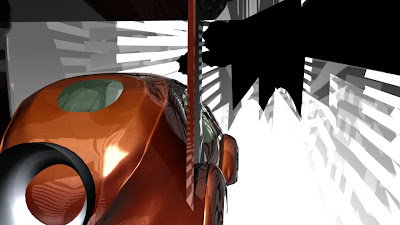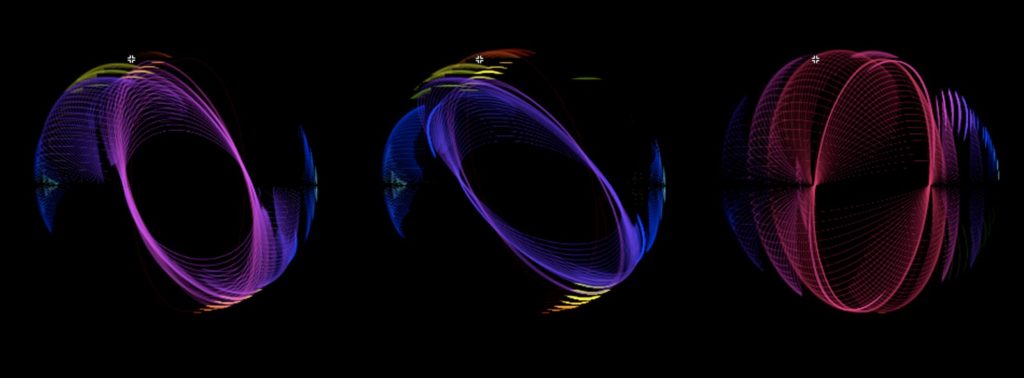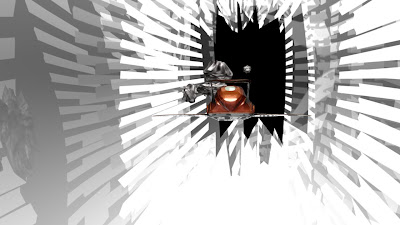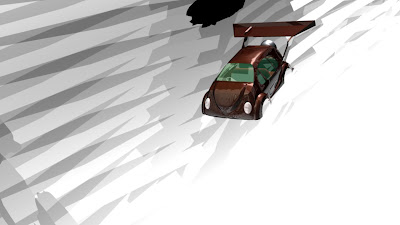Using an Arduino analogue electronics board I am attempting to create a fountain installation that makes a a stream of water droplets appear as though they are moving backwards in time. This aliasing effect is created by a strobe light that illuminates the droplets at certain intervals, often seen when filming a car wheel or helicopter blades. I really like how the illusion works in realtime in much the same way as a television or projector does. However, when we are able to actually interact with the animation directly, shown in the video below, it becomes a whole and complete illusion.
The electronics I am using in the Arduino are simply a means of powering and controling the rate of the strobe light and pump. Hopefully it will have some other applications when working on my innovation, especially with midi and interactive installations.
The code I am using to control the arduino board, which is coincidentally based on the processing programming language.
Author: adarabi
Processing Progress
Here is a graphic I managed to create from cratch just using the processing language. Although it is a very simple shape, I hope to develop the colour array as the oval shape is transformed. It would also be really nice to get some 3D movement in there, something which I am working on at the moment with the help of ‘Processing for Flash Developers’ by Ira Greenberg.
Cells4D
 High paced travel through space along a carpet of cells. I often visualise music as travelling through space, perhaps on the back of a rocket! I think this is one of the most effective visualisations of music whereby the drums are the engine driving you and the instruments could represent passing stars, nebulas and galaxies.
High paced travel through space along a carpet of cells. I often visualise music as travelling through space, perhaps on the back of a rocket! I think this is one of the most effective visualisations of music whereby the drums are the engine driving you and the instruments could represent passing stars, nebulas and galaxies.
This is possibly one of the first and best examples of sculpture mapping that I have seen. I find the simple effects on this 3D abstract sculpture stunning when in motion. I imagine that the sculpture was specifically designed to exemplify this technique. I also really like the idea of the piece being A/V, with sound effects reinforcing the visual, augmented reality of the sculpture. I usually describe mapping to people as virtual reality-reality, which is pretty much summed up by the description of augmentation. By placing the sculpture in the corner of the exhibition Valbuena has restricted the viewpoint to less than 180 degrees, making sure that the lines match up for the viewer and eliminating the need for more than one projector.
Mapping by ne1co @ Gods Kitchen
An awesome example of mapping on stage. Using an extremely simple structure ne1co and a collaborative based in France project onto the semi transparent material, giving a really nice 3D effect. I also really like how the DJ booth is central to the animation. I would really like to imitate using this technique as part of my innovation project, and hopefully find some unique angle to take on it. I have already documented myself trying to project onto 3D surfaces in situe, but I want to try and build something specifically to be mapped onto, and possibly with interactive properties.
Squideh
This ink drawing was given to me by a friend, I asked her if I could animate it in a simple way using a wave type effect on the creatures legs. The end result should form part of the underwater scene I am also working on at the moment.
Hall of Doors
A still from the Hall animation I am working on in Maya. I want to create a labyrinth of doors that the camera negotiates , adding to the 3D effect. The nice thing about this animation is that it is quite bold and loops very easily, it will hopefully be quite a sleek addition to the set. Here is a link to the original concept art: http://2.bp.blogspot.com/_XP2GUQJ-4Ts/SwhJlVGqh8I/AAAAAAAAAKY/9uZ0kc8q9M8/s1600/Hall.jpg
Above is the initial inspiration for the hallway taken from ‘The Yellow Submarine’ I would also like to create a canopy of archways over the hall as in the Beetles animation.
Spacebeetle

Here are a few stills from the beetle Simon and I put together in Maya. Although the beetle still needs abit of work, and a change in colour, I really like the background effect Simon came up with. We are currently putting together a way of animating this effect in time with a beat. You can also see a mock up of the ‘space junk’ that the Beetle will dodge and swerve, alot of the models for this I hope to source from Adam and Cherie, such as an oil drum from Adam, which we can put a radioactive glow onto in the textures editor. I may even chuck in a few of my own models from the Hallway design which I intent to document on here shortly.
Spirograph Development

Although Flash does use vectors which give out some quite bold and clean results, I am not impressed with the more recent 3D function encorporated into the program. Above I have taken some stills of an onion skin effect on the incremental3D animation to show what it might look like if a trail were to be left behind by each oval. In order to see this animated I will have to look into coding this 3D effect, and possibly leave Flash behind for processing which uses an OpenGL pixel based rendering method. It is a shame to not be using vectors as these usually give a more fluent, clean result, but when put into 3D it seems flash cannot handle it very well.
FUTURE DEVELOPMENT:: Use the stills above as a starting point to generate a similar effect using the processing 1.0 language. Hopefully I can also integrate colour evolution into the live drawing/animation.








